Al Sinniyah is nothing like the pearls laden with palaces and skyscrapers that form the luxurious string of Emirati islands.
The desert islet makes no waves along the southern coast of the Persian Gulf, north of Dubai.
This arid and sandy language, on the other hand, delights archaeologists in the United Arab Emirates.
They have unearthed there, in recent months, vestiges that are unexpected to say the least in this part of the world: a Christian monastery.
According to the first dating carried out on the remains discovered on site, the religious complex was founded between the end of the 6th and the beginning of the 7th century.
This would make it a site that predates the birth and spread of Islam in the Arabian Peninsula by a few decades, or even contemporary with it.
Read alsoEtruscan bronzes, Amazonian civilization and excavation of Notre-Dame... The most remarkable discoveries of 2022
Discovered as early as 2021, Al Sinniyah Monastery has been painstakingly cleared over the past year.
The site was entrusted to archaeologists from the University of the United Arab Emirates, in collaboration with New York University and the Italian archaeological mission of Umm Al Quwain.
"It's an extremely rare discovery
," rejoiced in the Emirati daily
The National
in November, the British archaeologist Tim Power, who participated in the excavation operation.
"The fact that there was a Christian Arab population in eastern Arabia has been somewhat forgotten,"
he continues.
This discovery is therefore an important reminder of a lost chapter in Arab history.”
Contemporary of the Islamic conquest
The religious site consisted of a single nave church, cells and a refectory.
A privileged residence, a courtyard house, which was to house the head of the community was also uncovered.
Structures related to daily life - cisterns, ovens, storage spaces... - completed the whole.
Among the most remarkable elements, the researchers reveal that they have identified possible baptismal fonts near the altar, as well as the remains of large glass chalices, undoubtedly ancient liturgical cups, for the Eucharist.
Read alsoArchaeology: discovery of a 3,700-year-old crime
The most recent vestiges of the site date from the middle of the 8th century, from the end of the Umayyad Caliphate, whose influence extended from the Atlantic coast to the Indus valley.
"The community was not the subject of a violent conquest, but was slowly abandoned"
, nevertheless points out Tim Power, who indicates that the archaeologists have not revealed traces of violent destruction of the monastery.
The memory of the site, like other monasteries, has faded over the centuries.
"It's a whole piece of hidden history, in short,"
summarizes Tim Power for the American agency Associated Press.
Al Sinniyah Monastery is the second such Christian settlement discovered in the United Arab Emirates since the 1990s, and the sixth around the Persian Gulf.
A few hundred meters from the monastery, the remains of two villages have also been excavated by researchers.
The first had been destroyed by the British in 1820. The second dated from pre-Islamic times.
On a visit to the site in November, the Emirati Minister of Culture, Noura Al Kaabi, assured that these various sites would be subject to heritage protection.
The island of Al Sinniyah was, after all, not so empty.







